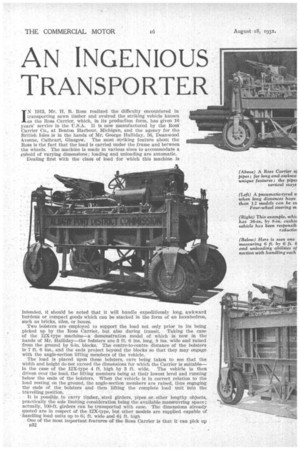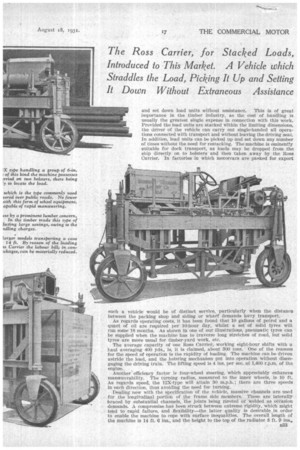AN INGENIOUS TRANSPORTER
Page 46

Page 47

Page 48

If you've noticed an error in this article please click here to report it so we can fix it.
The Ross Carrier, for Stacked Loads, Introduced to This Market. A Vehicle which Straddles the Load, Picking It Up and Setting It Down Without Extraneous Assistance IN 1913, Mr. EL B. Ross realized the difficulty encountered in transporting sawn timber and evolved the striking vehicle known as the Ross Carrier, which, in its production form, has given 16 years' service in the U.S.A. It is now manufactured by the Rosa Carrier Co., at Benton Harbour, Michigan, and the agency for the British Isles is in the hands of Mr. George Halliday, 56, Deanwood kvenue, Cathcart, Glasgow. The most striking feature about the Ross is the fact that the load is carried under the frame and between the Wheels. The machine is made in various sizes to accommodate a cuboid of varying dimensions; loading and unloading are automatic.
Dealing first with the class of load for which this machine is
intended, it should be noted that it will handle expeditiously long, awkward bui•dens or compact goods which can be stacked in the form of an hexahedron, such as bricks, tiles, or boxes.
Two bolsters are employed to support the load not only prior to its being picked up by the Ross Carrier, but also daring transit. Taking the case of the 12X-type machinea demonstration model of which is now in the hands of Mr. Halliday—the bolsters are 3 ft. 6 ins. long, 8 ins, wide and raised.
• from the ground by 6-in. blocks. The centre-to-centre distance of the bolsters
• is 7 ft. 6 MS.; and the ends project beyond the blocks so that they may engage with the angle-Section lifting members of the vehicle. The load is placed upon these bolsters, care being taken to see that the • width and height do not exceed the dimensions for which the Carrier is suitable— in the case of the 12X-type 4 ft. high by 3 ft. wide. The vehicle is then driven over the load, the lifting members being at their lowest level and running below the ends of the bolsters. When the vehicle is in correct relation to the load resting on the ground, the angle-section members are raised, thus .engaging the ends of the bolsters and then lifting the complete load unit into the
• travelling position.
It is possible to carry timber, steel girders, pipes or other lengthy objects,
• practically the sole limiting consideration being the available manouvring space; actually, 100-ft. girders can be transported with ease. The dimensions already quoted are in respect of the 12X-type, but other models are supplied capable of .-handling load units up to 62 ft. wide and 6i ft. high
One of the most important features of the Ross Carrier is that it can pick up n32 and set down load units without assistance. This is of great importance in the timber industry, as the cost of handling IS usually the greatest single expense in connection with this work. Provided the load units are stacked within the limiting dimensions, _ the driver of the vehicle can carry out single-handed all operations connected with transport and without leaving the driving seat. In addition, load units can be picked up and set down any number of times without the need for restacking. The machine is eminent!y suitable for dock transport, as loads may be dropped from the ship directly on to bolsters and then taken away by the Ross Carrier. In factories in which motorcars are packed for export such a vehicle would be of distinct service, particularly when the distance between the packing shop and siding or wharf demands lorry transport.
As regards operating costs, it has been found that 10 gallons of petrol and a quart of oil are required per' 10-hour day, whilst a set of solid tyre.s will rtm.some 18 months. As shown in 'one of our illustrations, pneumatic tyres can be supplied when the machine has to traverse long stretches of road, but solid tyres are more usual for timber-yard work, etc.
The average capacity of one Ross Carrier,' working eight-hour shifts with a haul averaging 400 yds., is, it is claimed, about 300 tons. One of the reasons for the speed of operation is the rapidity of loading. The machine can be driven astride the load, and the hoisting mechanism put into operation without disengaging the driving train. The lifting speed is 4 ins, per sec. at 1,400 r.P.m. of the engine..
Another' efficiency factor is four-wheel steering, which appreciably enhances manoeuvrability. The turning radius, measured to the inner wheels, is 10 ft. As regards speed, the 12X-type will attain 30 m.p.h.; there are three speeds in each direction, thus avoiding the need for turning.
Dealing now with the specification of the vehicle, massive channels are used for the longitudinal portion of the frame. side members. These are laterally doraced by substantial channels, the joints being riveted or welded as OCCasion demands. A compromise has been struck between extreme rigidity, which might tend to rapid failure, and flexibility—the, latter quality is desirable in order to enable the machine to cope with surface inequalities. The overall length of the machine is 14 ft. 6 ins,, and the height to the top of the radiator 8 ft. 9 ins.,
whilst the overall width is 6 ft. 1 in. Al].four wheels are controlled by a Ross cam-and-lever steering set, the wheel's being individually sprung, and the drive is taken to the two rear ones.
For the power unit, a Continental 50 b.h.p. fourcylindered engine is eniployed, or a six-cyiindered 70 b,h.p. motor. In the bell housing for the clutch is the gearing giving forward or backward motion, and the power is then conveyed-by a universally jointed shaft to the three-speed gearbox which is mounted directly on to the differential casing. Thence, power. is .carried to the rear wheels by roller chains. Care has been taken to employ exceptionally wide gearwheels, and all splined shaftsare ground on the sides of the splines and in the " valleys " to ensure accurately fitting gears.
Power for the Hoisting Mechanism.
For the hoisting mechanism, power is taken from the front end of the crankshaft, through helical gears and universal joints, to a raw-hide friction drive. From this point, power can be transmitted in either direction—according to the setting of a lever—to give the desired upward or downward motion for the anglesection _ load-carrying members. These are .raised or lowered by two left-hand and two right-hand rotating bronze nuts housed in oil-tight casings. These nuts force upwards or downwards the vertical bars to which are attached the load-carrying members. The nuts are supported by self-aligning thrust bearings.
As the vehicle is driven over the load, the liftingmechanism is swung Outwards. So soon as the burden is in the right position for raising, the load-carrying members move inwards and are locked against the ends of the bolsters; the lifting operation then follows, and 'the vehicle can drive away. As a rule, it takes 10 seconds to get astride the load and set the lifting bars; another 10 seconds suffice for the actual raising of the burden, and the vehicle complete with the package of timber, bricks, etc., is under way in about half a .minute from the time of commencing to straddle the. pay-load. This is, of course, a period appreciably shorter than that required by a skilled crane operator to load a conventional vehicle.
A Variety of Uses.
Detail features in the specification include Auto Lite lighting and starting, there being a Bosch magneto and impulse starter. Brakes are provided on the transmission, these being operated hydraulically and mechanically. This interesting 'machine, which offers a number of poisibilities for industries other than those 'connected with timber, bricks, etc., can now, be' demonstrated by Mr. Halliday. Its employment, offers extensive advantages in industries in which handling of the load is a costly item. The unique principles of the Ross Carrier are certain, in many; instances, to throw new light upon the transport question.




























































































